Decorative plates: materials, sizes and designs
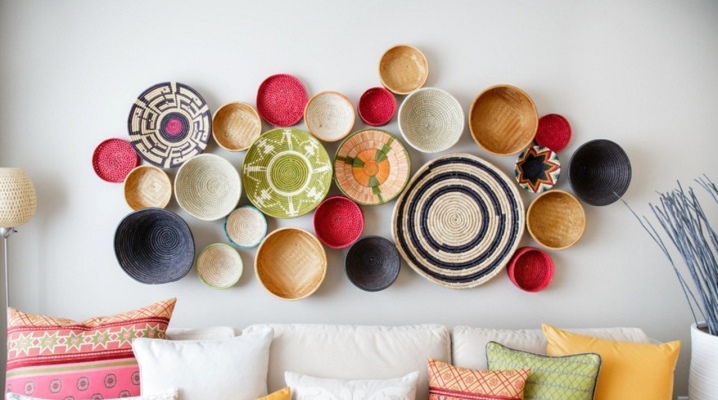
Porcelain painted plates are a new trend in the field of interior decoration. They are placed in the living room, in the kitchen and even in the bedroom. The main thing is to choose the right style, the shape of the plates and the type of placement.
Peculiarities
Souvenir plates are increasingly used as interior decor elements... This is no longer considered a sign of some kind of bourgeois, "village" chic, as before. Now this design is at the peak of popularity, and many designers resort to it when creating unique, atmospheric interiors.

Decorative plates are brought from trips as a keepsake instead of bored magnets and are placed in a conspicuous place. They can fit into almost any interior - from classic to country. It all depends on the color scheme of the dishes, the material from which it is made, its shape and the applied image.
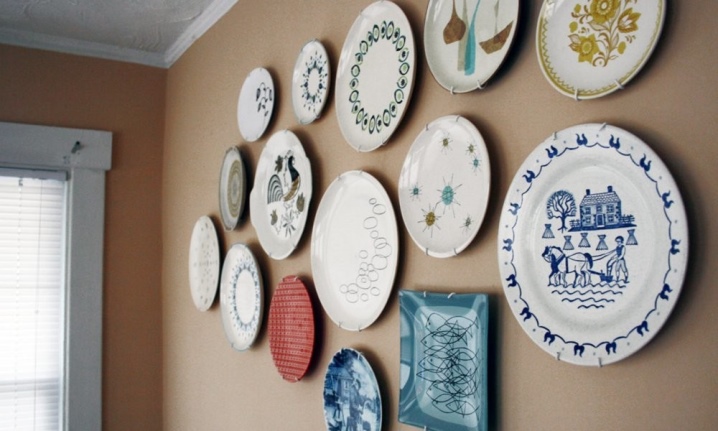
It is also important to take into account such a factor as the color design of the interior itself. It should be in harmony with the colors of the plates.
In the composition itself, wall plates should also be combined. Shape, color, pattern, theme - they must be united by at least one of these signs. Painted, non-monochromatic models require a particularly rigorous approach to placement and layout. An interior composition of this kind should look accordingly, be harmonious, carefully thought out in terms of combining details both with each other and with all other interior elements. The placement of the plates inside the composition is also important.
They can be arranged as follows.
- In one or more rows.

- Create a symmetrical composition.

- Cover the entire free wall with plates.

- Lay out a wave, an arch from them (when decorating, for example, a window opening or a wall mirror) or some kind of fantasy pattern.

- Accommodation from small to large possible or large to small when based on cymbal size.

- You can focus on the doorway by decorating it with dishes... Indeed, often when decorating a room, this area remains "out of work".

- In the end, you can place the plates in any arbitrary shape, as the fantasy and style of the interior suggest.

In order to choose the right option for the location of the dishes and at the same time not spoil the walls with unnecessary holes or traces of glue, you should proceed as follows. Attaching the plates to a sheet of paper or cardboard, you need to circle them and cut out the resulting templates. Lay out a draft of the future composition on the wall and fix the layouts using a special mounting adhesive tape for painting. In this way, you can find the optimal arrangement of the plates without trying to ruin the wall. As soon as the best placement option is found, the layouts are outlined with chalk or pencil, and the dishes themselves are already fixed according to these marks.

In addition, you need to take into account the background on which the elements will be located. For example, if the wall is painted a dark color, it is better to place bright details on it. Pastel shades require the same color scheme on the plates.


If the dishes will be placed on wallpaper with a pattern, you need to make sure that the pattern on the plates matches it.
Materials and sizes
Decorative wall plates are made from different materials, but the most popular are porcelain, ceramic and faience products. There are also wicker models, but not every interior can withstand their special, ethnic flavor.
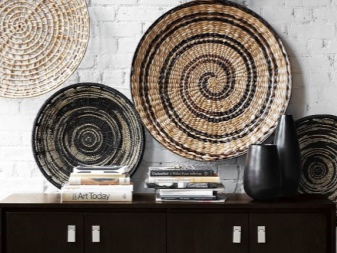



Porcelain plates are considered more expensive than all other options. They are distinguished by lightness, whiteness and special transparency - in the light they seem to let rays through themselves. Such products can be monochromatic, with a pattern, ornamentation, have a wide variety of shapes and colors, but in any case, porcelain plates on the wall will give the interior a certain status, unobtrusive chic.
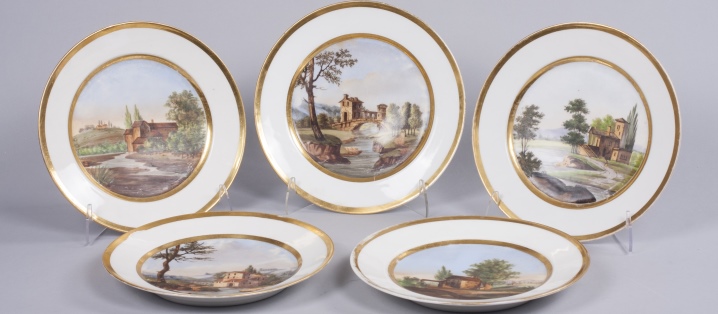
Ceramic tableware is cheaper than porcelain and often offers a wider range of colors and shapes. Even the simplest plate without decorations and drawings has its own indescribable charm. Ceramics is, to some extent, a tribute to tradition.
Even if it is not as thin and graceful as the same porcelain, it has its own inherent advantages only: environmental friendliness, special color, a wide range of shapes, sizes and colors. It is not for nothing that clay dishes are so popular in our time.
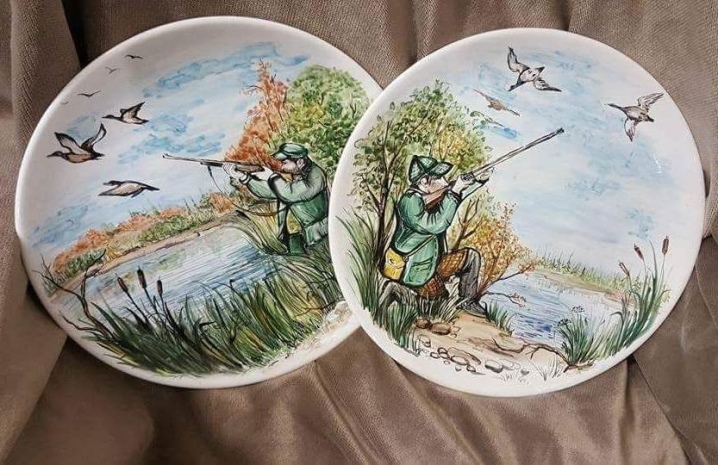
The most affordable option is earthenware dishes. Thanks to modern technology, plates made of this material are of high quality and are often not inferior to porcelain. They are as attractive and aesthetic as porcelain, but cheaper, which means earthenware dishes are available to more fans of this type of decor.

A separate type of tableware is wicker products.... They practically do not have any utilitarian function. If a porcelain, ceramic or earthenware plate, if necessary, can be used for its intended purpose, then wicker is just a decor, and one that will not be appropriate in every interior.

It is obvious that the classics "will not accept" this kind of decoration, but ethno, country or stylization for any exotic style (African, Moorish, etc.) will easily cope with such a decor, and it will be appropriate.
Such plates are effective in themselves due to the manufacturing method, they do not need additional "decoration", so they rarely have any drawing or pattern applied to them.
When choosing the type of decorative plates, you need to take into account their aesthetic properties, and the features of the interior in which they will be located, and the cost of products. The latter aspect plays an important role for many. A wide range of various models for any wallet will allow you to choose the best option without compromising the decorative and aesthetic qualities of the plates.
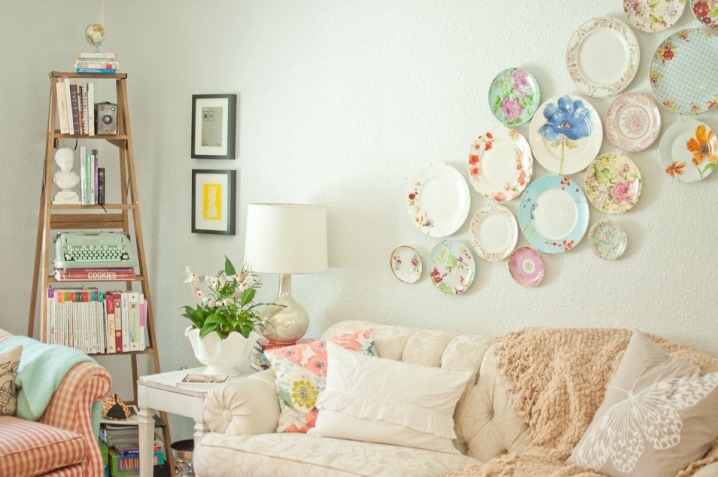
Design options
The design of the plates can be very diverse, which will allow them to fit into almost any interior. Inscriptions, floral or geometric ornaments, portraits, landscapes and many other options for images are now applied to decorative plates. Perhaps this is what partly explains the wide popularity enjoyed by wall dishes.
If earlier it was fashionable to bring fridge magnets from travel, now decorative plates have firmly taken their place. Dishes with views of Russian cities will allow you to create a composition reminiscent of a journey through your native country. An interesting idea: draw a map of the world or Russia on an empty wall and place the plates according to the location of the cities or countries from which they were brought. For this, the wall must be large enough and the dishes compact so as not to clutter up the drawing.

The plates can depict different countries, their characteristic landscapes, city panoramas, sights, etc. Such decor can become a bright accent in a room, attracting attention at first sight. Plates with voluminous birds, animals, some plant motifs are in the widest demand. This is a kind of classic adapted to modern requirements.

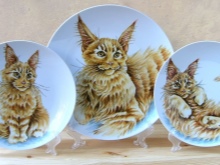

It is not difficult to fit plates with such images into the interior, the main role here is played by the colors of the dishes themselves and the palette of the room where it is planned to be placed.
Plates with inscriptions are a more avant-garde, unconventional option. The inscriptions can be large or small, bright or black and white, additionally equipped with some images, or they can be the only decor of the dishes. Black letters on a white background look strict, laconic, restrained, and this is what they attract. Plates with such decor will not be conspicuous, but they will not go unnoticed either. Lovers of discreet chic “simple but tasteful” will appreciate this decor.

Bright, intricate ornaments in the Arabian style will look good in an ethnic interior filled with oriental flavor. A simple, laconic style will also easily "withstand" such decor - it will become a spectacular accent that attracts the eye.
And this is not a complete list of those images that can be applied to decorative wall plates. In addition to ready-made solutions, many companies offer such a service as applying an author's image. It can be a portrait, a favorite landscape, a photograph, or an abstract drawing - whatever. Such unique decor items will become a real highlight of the interior, its center, from which you will need to build on when decorating a room.




Manufacturers overview
Decorative plates are produced by many companies, but the most popular are products from the following manufacturing countries:
- Germany;
- Czech;
- Italy;
- China;
- India.





Each plate has its own fans. Someone likes Chinese plates, someone prefers Czech or Italian. There are no special differences between them - the same materials, similar technologies. The difference is the ornaments that are applied to the dishes, and the cost of the finished product.
It is difficult to single out any one manufacturer, the buyer himself decides whose products to choose based on personal preferences and financial capabilities.
How to choose?
In the choice of wall plates, the main role is played by the individual preferences and taste of the owner of the room, which is planned to be decorated in this way. The style of the interior, the color scheme, the size and purpose of the room must also be taken into account so that the decor looks harmonious and appropriate. For example, in a classic interior decorated in light, pastel colors, plates of the same shades will look good. Ivory, beige, white, powdery and similar colors will organically fit into such an interior.

In this case, it is important to take into account the design of the wall on which the dishes will be located. If it is simply painted with light paint, you can safely hang plates on it, caring only about drawing up a harmonious composition. If wallpaper is pasted on the wall, you need to choose such models of dishes that will be combined with each other and with the pattern on the wallpaper. In the classics, it is not necessary to use plain plates. Some kind of drawing may well be applied to them, for example, a floral ornament, a landscape, a view of the city.

The main thing is that all the individual elements can make up a single whole - an integral, harmonious composition and do not "argue" with other details of the decoration.
But if, with an independent choice, you can figure out how this or that plate will fit into the interior and choose the best option, then if it was received as a gift, some misunderstandings are possible. A gift cannot always be inscribed in the created interior, and finding a worthy place for it can be problematic.
In this case, there are two ways:
- remove the donated plate away;
- make it the center of the whole "cymbal" composition.
In addition, you can begin to collect a collection of just such "donated" plates, arrange it in plain sight and in this way create a bright, unusual accent in the interior.However, in this case, all other elements should be discreet in order to only emphasize the beauty of the collection, and not distract attention from it. Handmade gift plates are recognized by many as a separate art form.

Like any other kind of hand-made, such dishes are characterized by a special flavor, a unique charm. It can rightfully be called unique. And it is these plates that often become the center of the entire interior, setting the tone for the rest of the decoration. The color scheme, accompanying decor, textiles and everything else are selected in such a way as to emphasize the beauty of the designer tableware.


Choosing such plates, you need to take into account their individual character, style, color scheme.
Collectible plates also belong to the category of unique decor items that require not only the right framing, but also the appropriate attitude. They are well suited for the decor of a retro interior that recreates a particular era. In this, as in any other case, it is necessary to take into account the color palette and "character" of both the plate and the interior itself.
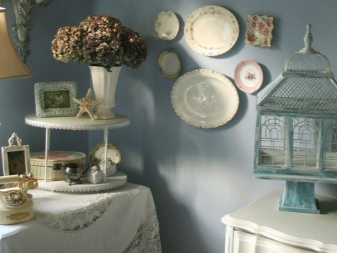

Award, personalized dishes, plates, which depict memorable places or moments, are also to some extent collectible. But they represent not material value, but spiritual value. Such decor will make the interior of the room more soulful, warm, individual, it will emphasize the personality of the room, tell about who lives in it.


With all the popularity of "plate" decor and a wide range of options, many still believe that it is only suitable for the kitchen. Far from it. Decorative plates will look organically in the living room, in the bedroom, and in the hallway. The main thing is to choose the right dishes and placement. It is also important to consider the background color on which the plates will be located.
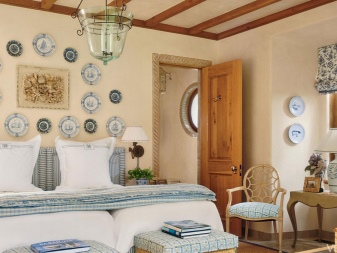

So, if the dishes are bright and catchy, it is better to place them on a dark plain wall. Plates in pastel colors will look good on a light background, which should be slightly lighter than the dishes. If wallpaper with some kind of ornament is pasted on the wall, the plates should form a single composition with it.
Use as decoration
Plates as a decor - a non-standard solution. Nevertheless, more and more designers are using this technique when decorating interiors. The location of the dishes depends on the personal preferences of the owner of the room being decorated. They can be simply hung on the wall, covering the entire surface, they can be placed in a niche, on open shelves, or an original panel can be laid out of them.
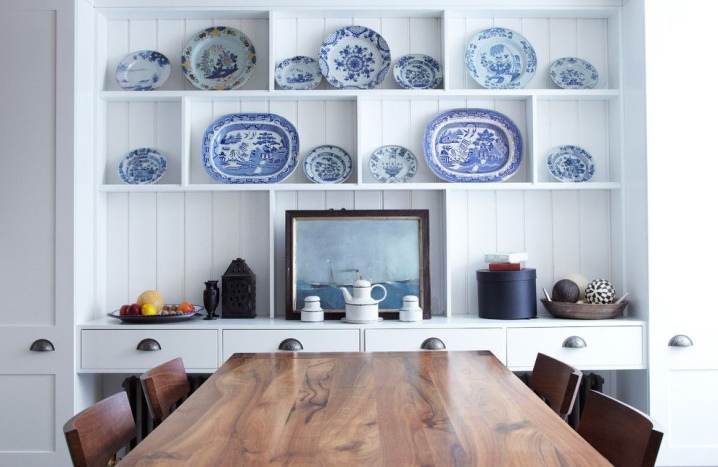
A door or window opening, designed in this way, looks interesting. The space near doors and windows is rarely used as a "springboard" for decoration and is a blank slate for all sorts of experiments. In the hallway or living room, plates can be positioned above a dresser or console. A mirror surrounded by decorative plates will look interesting and unusual.


In the bedroom, the headboard will be the best place to place the dishes. This will allow you to create an emphasis on the sleeping area and decorate the wall, which often remains empty. Arrangement of plates in a row (one or more, horizontally or vertically) is a classic solution that does not lose its relevance. This technique can be used if you need to arrange an empty wall in the room, close it.

In this case, the surface on which the dishes will be located should either be painted in one color, or covered with wallpaper with a discreet pattern.
As a bright accent, you can use a panel of plates. When creating it, it is better to use dishes that are not just combined with each other, but allows you to create an integral composition with a pronounced, understandable general idea. It is not necessary to follow the principle of puzzles, when a large picture is made from small elements that do not carry any meaning separately.Each of the plates in such a panel usually represents an independent decorative unit, but as part of the composition, they reveal their beauty to the fullest.


Another popular technique is placing plates randomly on an empty wall. Dishes of different sizes, colors and shapes will look good here. But this method requires a particularly careful selection of the cymbals and their place within the composition. In solving this problem, the use of mock-ups will help - figures cut out of cardboard or paper, repeating the outlines and sizes of the plates. Such templates can be easily moved, swapped to find the best location, and only then start attaching real plates.

There are many methods for placing decorative plates, it all depends on the imagination of the person and the characteristics of the interior. Walls, niches, open shelves; chaos or strict brevity - it doesn't matter.
The main thing is that the created composition is harmoniously combined with other finishes and emphasizes the individual beauty of the interior.
For information on how to make a simple and reliable suspension for a decorative plate, see the video below.









The comment was sent successfully.